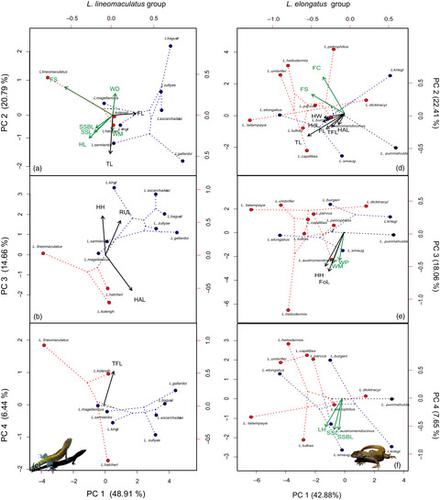Our official English website, www.x-mol.net, welcomes your
feedback! (Note: you will need to create a separate account there.)
Male genitalia's evolutionary rate is higher than those of body traits: the case of two Liolaemus lizards' group
Journal of Zoology ( IF 1.9 ) Pub Date : 2020-10-02 , DOI: 10.1111/jzo.12836 A. M. Quipildor 1 , M. R. Ruiz‐Monachesi 1 , S. Ruiz 1 , T. N. Hibbard 1 , S. Valdecantos 1, 2 , F. Lobo 1, 2
Journal of Zoology ( IF 1.9 ) Pub Date : 2020-10-02 , DOI: 10.1111/jzo.12836 A. M. Quipildor 1 , M. R. Ruiz‐Monachesi 1 , S. Ruiz 1 , T. N. Hibbard 1 , S. Valdecantos 1, 2 , F. Lobo 1, 2
Affiliation

|
Different studies suggest that reproductive characters evolve faster than non‐reproductive characters. Males in the order Squamata have paired copulatory organs called hemipenes, with high morphological diversity, including differences in size, shape, and ornamentation. Some studies in the species‐rich lizard genus, Anolis suggest that genital traits evolve faster than the rest of the body. However, these studies were made considering only a few traits, across a wide phylogeny, without considering species relatedness, which may inflate differences in evolutionary rates. Here, we study two phylogenetic distantly related lizard groups, which differ in the number of species, but have similar divergence times. We evaluate as follows: (1) evolutionary rate, models of evolution and phylogenetic signal among the different genital and non‐genital traits; (2) which kind of traits (genital and non‐genital) are divergent across sister species and (3) whether the species‐rich group shows a faster rate of trait change. We studied 24 Liolaemus lizard species, belonging to two monophyletic groups that differ in species number: L. elongatus' clade, which has more species than L. lineomaculatus' clade. We studied 20 different traits (9 genital and 11 non‐genital) and calculated their phylogenetic signal, evolutionary rate of change and models that best explain the evolutionary change. Our results show that: (1) in general, genital traits evolve faster than non‐genital ones in both groups, and both phylogenetic signal and best evolutionary model vary depending on the trait. (2) Genital traits diverged more among sister species within the L. lineomaculatus group, but within the L. elongatus group, both sets of traits show similar degrees of divergence. Finally, (3) the species‐rich group (L. elongatus), has the highest genital evolutionary rate but also the highest non‐genital evolutionary rate.
中文翻译:

男性生殖器的进化速率高于身体特征的进化速率:以两只Liolaemus蜥蜴为例
不同的研究表明,生殖性状的发展比非生殖性状发展得更快。鳞翅目雄性具有成对的交配器官,称为半足类,具有高度的形态多样性,包括大小,形状和装饰的差异。对物种丰富的蜥蜴属Anolis的一些研究提示生殖器性状的进化要快于身体其他部位。但是,进行这些研究时仅考虑了广泛的系统发育中的几个性状,而没有考虑物种的相关性,这可能会加剧进化速率的差异。在这里,我们研究了两个系统发育远缘的蜥蜴组,它们的物种数量不同,但发散时间相似。我们评估如下:(1)不同生殖器和非生殖器性状之间的进化速度,进化模型和系统发育信号;(2)姊妹物种的哪些性状(生殖和非生殖)是不同的;(3)物种丰富的群体是否表现出更快的性状变化。我们研究了Liolaemus蜥蜴的24个物种,它们属于物种数量不同的两个单生类:L. elongatus的进化枝比L. lineomaculatus的进化枝具有更多的种类。我们研究了20个不同的特征(9个生殖器特征和11个非生殖器特征),并计算了它们的系统发育信号,进化变化率和最能解释进化变化的模型。我们的结果表明:(1)总体而言,两组的生殖器性状的发展都快于非生殖器性状,并且系统发育信号和最佳进化模型均因性状而异。(2)在L. lineomaculatus组的姐妹种之间,生殖器性状的差异更大,但是在L. elongatus组中,这两组性状的分化程度相似。最后,(3)物种丰富的群体(L. elongatus),生殖器进化率最高,但非生殖器进化率最高。
更新日期:2020-10-02
中文翻译:

男性生殖器的进化速率高于身体特征的进化速率:以两只Liolaemus蜥蜴为例
不同的研究表明,生殖性状的发展比非生殖性状发展得更快。鳞翅目雄性具有成对的交配器官,称为半足类,具有高度的形态多样性,包括大小,形状和装饰的差异。对物种丰富的蜥蜴属Anolis的一些研究提示生殖器性状的进化要快于身体其他部位。但是,进行这些研究时仅考虑了广泛的系统发育中的几个性状,而没有考虑物种的相关性,这可能会加剧进化速率的差异。在这里,我们研究了两个系统发育远缘的蜥蜴组,它们的物种数量不同,但发散时间相似。我们评估如下:(1)不同生殖器和非生殖器性状之间的进化速度,进化模型和系统发育信号;(2)姊妹物种的哪些性状(生殖和非生殖)是不同的;(3)物种丰富的群体是否表现出更快的性状变化。我们研究了Liolaemus蜥蜴的24个物种,它们属于物种数量不同的两个单生类:L. elongatus的进化枝比L. lineomaculatus的进化枝具有更多的种类。我们研究了20个不同的特征(9个生殖器特征和11个非生殖器特征),并计算了它们的系统发育信号,进化变化率和最能解释进化变化的模型。我们的结果表明:(1)总体而言,两组的生殖器性状的发展都快于非生殖器性状,并且系统发育信号和最佳进化模型均因性状而异。(2)在L. lineomaculatus组的姐妹种之间,生殖器性状的差异更大,但是在L. elongatus组中,这两组性状的分化程度相似。最后,(3)物种丰富的群体(L. elongatus),生殖器进化率最高,但非生殖器进化率最高。











































 京公网安备 11010802027423号
京公网安备 11010802027423号